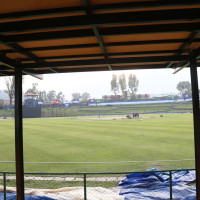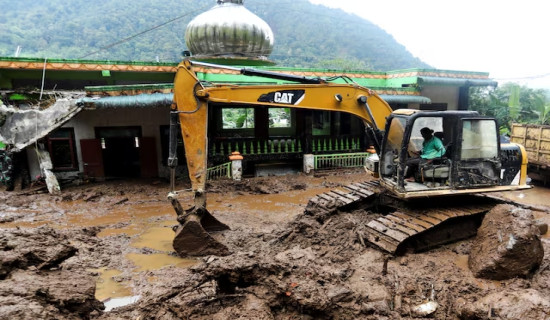- Thursday, 28 November 2024
Lumpy skin disease wreaks havoc on cattle in absence of effective measures
By Laxman Kafle & Nayak Paudel,Kathmandu, July 23: Animal husbandry farmers all over the country are worried as the spread of lumpy skin disease has not come under control even four months after since its outbreak.
Lumpy Skin Disease (LSD), is a vector-borne viral disease of cattle and buffalo caused by the LSD virus belonging to the Poxviridae family. It has created havoc for the country's farmers as a large number of cattle died and thousands of others are infected.
The nation has incurred huge losses in animal wealth. The LSD did not only cause a huge loss to the national economy but has left some farmers' sheds empty.
Characterised by nodules on the skin, the disease is highly contagious and mostly transmitted by mosquitoes and other hematophagous (those feeding on blood) insects. Similarly, sores appear on the snout, mouth and nose of infected cattle, and excessive fluid is discharged from eyes and nose.
Lumpy skin disease, which is mainly seen in Sub-Saharan Africa, Middle East and Turkey, was found in Israel in 1989. The first cases in South Asia were detected in 2019, and it has since spread to India, China and Nepal. In Nepal, the disease was first reported in Sundarharaicha Municipality of Morang district on June 25, 2020.
Due to the lumpy skin disease, many farmers have lost their only source of income with the death of milking cows and buffaloes, and since there is no provision of getting compensation from the government, they are worried about their future.
Until two years ago, the disease had affected 3,301 cattle in 16 districts and 13 of them had died.
The second wave of the disease started in March 2023. Since then, the disease has sickened around 800,000 cattle, mostly cows and buffalos, according to the Department of Livestock Services (DoLS). Of them, 28,424 have died and around 227,151 cattle are still infected.
Farmers said that due to a lack of attention from all three tiers of the government - federal, provincial and local – in time to control the disease, it spread across the country resulting in huge losses. Now, the disease has turned into an epidemic leading to a drop in milk production, emaciated animals and birth issues.
Dr. Chandra Dhakal, the spokesperson for the DoLS, said that the lumpy skin disease had spread in all 77 districts as an epidemic within four months of its outbreak in March this year.
The disease, which was earlier mostly found in the Tarai districts, has reached even the districts in the Hilly and Himalayan regions, including the remotest parts of the country.
Officials argued that the mortality rate in the case of lumpy skin disease was two to three per cent on average; however, the damage still prevails in infected animals after recovery.
According to the Food and Agriculture Organisation (FAO), infected cattle usually need several months to recover and are unlikely to return to the same level of production as before LSD infection.
Out of 800,000 infected cattle, the highest numbers of cattle (215,786) were infected in Karnali Province, followed by 214,645 in Koshi and 200,798 in Sudurpashchim Province.
Similarly, 74,289 cattle were infected in Lumbini Province, 48,139 in Gandaki Province and 40,372 in Bagmati Province. The lowest number of cattle (5,088) infected with lumpy skin disease was in Madhes Province.
The highest number of cattle (10,939) died in Sudurpashchim Province followed by 6,741 in Karnali and 4,814 in Koshi.
While the damage to the nation’s economy by the LSD epidemic in the past three months is in billions, the sheds of animal husbandry farmers, for whom a milking cow/buffalo was the sole source of income, are now empty leaving them in dismay.
Huge economic losses
“The nation has lost billions due to LSD. As per the preliminary projection, the country has incurred a loss of Rs. 40 billion while around 800,000 cattle were infected by the diseases,” said Dr. Manoj Kumar Shahi, the spokesperson of the Nepal Veterinary Council (NVC).
According to him, the cost of damage by the infection per cattle is Rs. 49,135.
Besides, farmers will bear additional losses as the milk production of infected animals will reduce and also affect reproduction capacity in them. Depending on the infection, it takes at least 10 to 45 days for infected cattle to recover.
Animal husbandry is a major income source for a large number of the country’s population as around 60 per cent of the total population is dependent on agriculture and livestock.
The contribution of livestock to the gross domestic product (GDP) stood at around 6 per cent and agricultural gross domestic product stood at over 30 per cent. However, the prevention and control of such a disease, which appeared three years ago and could become an epidemic, has not been a priority of all three-tire governments in the past three years.
“LSD prevention was not a priority for many which led to the current situation,” said Dr. Shahi.
However, some local levels have actively worked to prevent lumpy skin disease by allocating budget by reducing expenses in other priority sectors, said Dr. Dhakal.
According to Dr. Dhakal, Madhes should have been the most affected province if looked at the data of the previous two years as its districts were affected the most. “However, the rate of infection is the lowest in Madhes during the epidemic. It shows that the farmers were prepared from the earlier experiences,” he added.
Treatment of LSD
While vaccination is the best preventive measure against LSD, infected cattle cannot be vaccinated. Thus, when an animal is infected, veterinarians advised that the treatment should be based on the symptoms of the respective animal.
According to veterinarians, paracetamol can be used to reduce fever, symptom-based medicine to reduce itching and antiseptic ointment can be used to clean the wounds.
Farmers have also been suggested to feed infected cattle enough because they need more food and liquid to gain immunity against the virus.
Dr. Dhakal informed, "As soon as we know that cattle are sick, we should isolate them, and not use them to pull carts or plough. Smoke can be generated through traditional methods around the shed to prevent flies, mosquitoes and ticks.”
Preventive steps
As there is no specific treatment for this disease, DoLS spokesperson Dhakal advised vaccinating cows and buffaloes before they are infected, paying attention to cleanliness to keep the shed free from flies, mosquitoes and other insects, and not allowing water to accumulate around the shed.
Likewise, the FAO highlights the requirement of cleaning and disinfecting personnel, premises and the environment as the LSD is very stable and survives well in extremely cold and dry environments within the pH range 6.3-8.3.
“Infected animals shed scabs from skin lesions. Inside the scabs, the virus may remain infectious for several months. Thorough cleaning and disinfection with appropriate products should be performed on affected farms, trucks, premises and potentially contaminated environments. Personnel should also undergo disinfection,” read a field manual on LSD for veterinarians by the FAO.
What has been done?
Dr. Dhakal said that the department has been working to prevent and control the disease since the outbreak three years ago.
He said, "After the symptoms appeared in the cow, a sample was collected from the animal and tested by molecular method at the Central Livestock Disease Research Laboratory, Tripureshwor, and a laboratory report was obtained confirming Lumpy Skin Disease on 27 July 2020."
The Department has given approval for bringing vaccination against the diseases in November 2021 and farmers are willing to vaccinate their cattle, he said.
According to the data provided by the DoLS on Thursday, around 256,178 cattle had been vaccinated. “The local levels are providing vaccination services on subsidy lately,” said Dr. Dhakal.
He said that the DoLS had allocated a budget of around Rs. 76 million for the local levels for the vaccination and control of the disease for the last fiscal year.
He also said that the Department was also preparing to provide an additional budget to control disease for the current fiscal year.
Some veterinarians argued that the government should have stopped animal movement and the animal market to prevent further spread of the disease. However, only a few wards have taken the initiative as a preventive measure.
No vets in 516 municipalities
Since infected cattle need proper treatment, veterinarians’ availability is an important step to tackle the epidemic. However, there was a problem to prevent and treat the lumpy skin disease in cattle in time due to the lack of sufficient budget and manpower.
The lack of coordination among the federal, provincial and local governments also affected the task to control disease, he said. Dr. Shahi, the spokesperson of the NVC, said that there were no veterinary doctors in 516 out of 753 local levels across the country.
According to the NVC, at least one veterinarian should be posted in every municipality for the treatment of livestock diseases, but there are only 237 local levels with a veterinarian. Of them, only 126 of them are permanent.
“The lack of vets in the municipalities is a major bottleneck to preventing diseases and treatment of infected animals,” said Dr. Dhakal.
Dr. Dhakal informed that the DoLS had allocated conditional grants for recruiting veterinary doctors in 346 municipalities for the last fiscal year. This year, the department has allocated a budget to pay for veterinarians at 161 local levels due to a shortage in budget.
Not only doctors, but also the number of animal health technicians required in every ward is far from enough. Because of this, the LSD in cows and buffaloes, which is currently spreading in 77 districts of the country, has become a trouble.
According to Dr. Shahi, there is a shortfall of around 3,600 animal health technicians at the ward level.
No provision for compensation
According to Dr. Dhakal, there is no act for providing compensation for the death of cattle caused by lumpy skin disease.
Due to the lack of a law for providing compensation to farmers who incurred a loss over the death of cattle caused by the lumpy skin disease, there is no discussion of the issue of compensation to farmers to date, he said.
Only the farmers who had insured his/her cattle have a chance of getting compensation through insurance. However, not every farmer insures their cattle. Meanwhile, for those who insure the cattle, the government provides a subsidy of 80 per cent in the insurance premium. The government is spending around Rs. 100-150 million in premium subsidy of livestock insurance monthly, informed the DoLS.
Way forward
Government officials working in the animal health sector informed that the federal system had led to a decline in manpower at the local as well as district levels.
Similarly, they informed of a lack of coordination between the three tiers of the government. While a local level can actively look after the problems in their area, officials suggested local levels allocate a certain budget for emergency scenarios even by diverting the budget allocated for other sectors.
"There are many other more fatal diseases than the lumpy skin disease that have a high mortality rate, for example, bird flu has a 100 per cent mortality rate. So, we have to pay attention to building mechanisms among the federal, provincial and local governments to prevent the diseases in the first place," said Dr. Dhakal.



-original-thumb.jpg)




-square-thumb.jpg)








